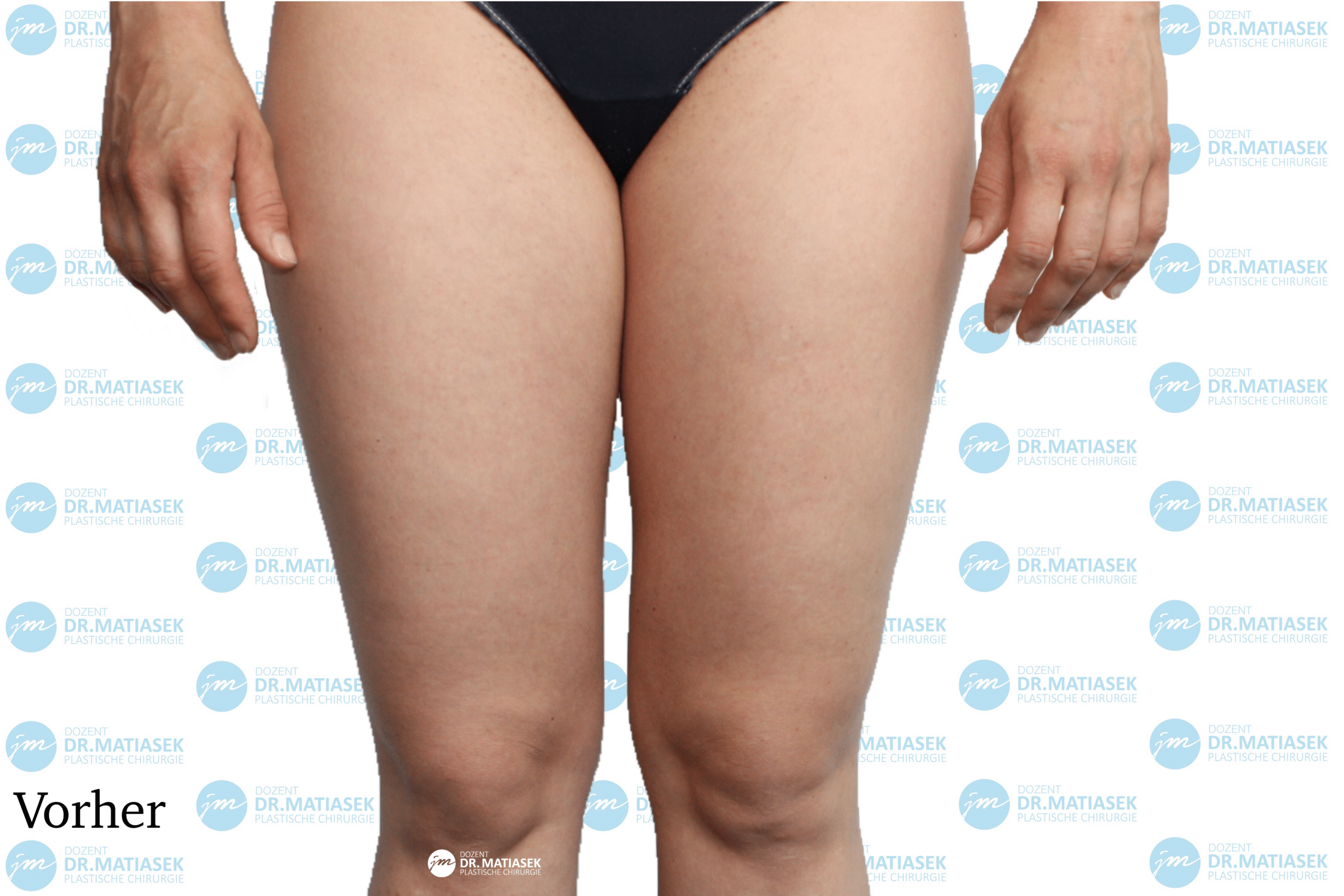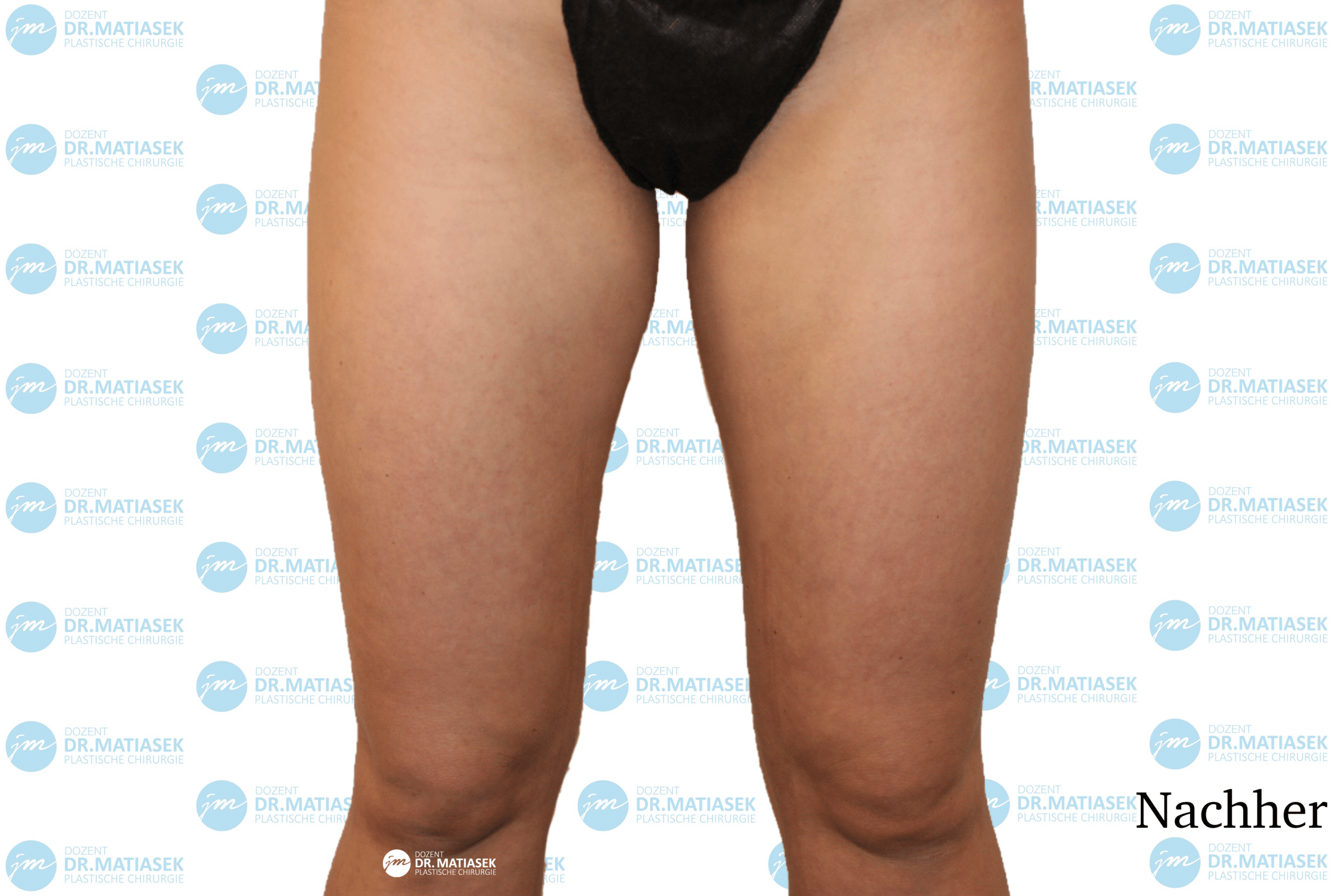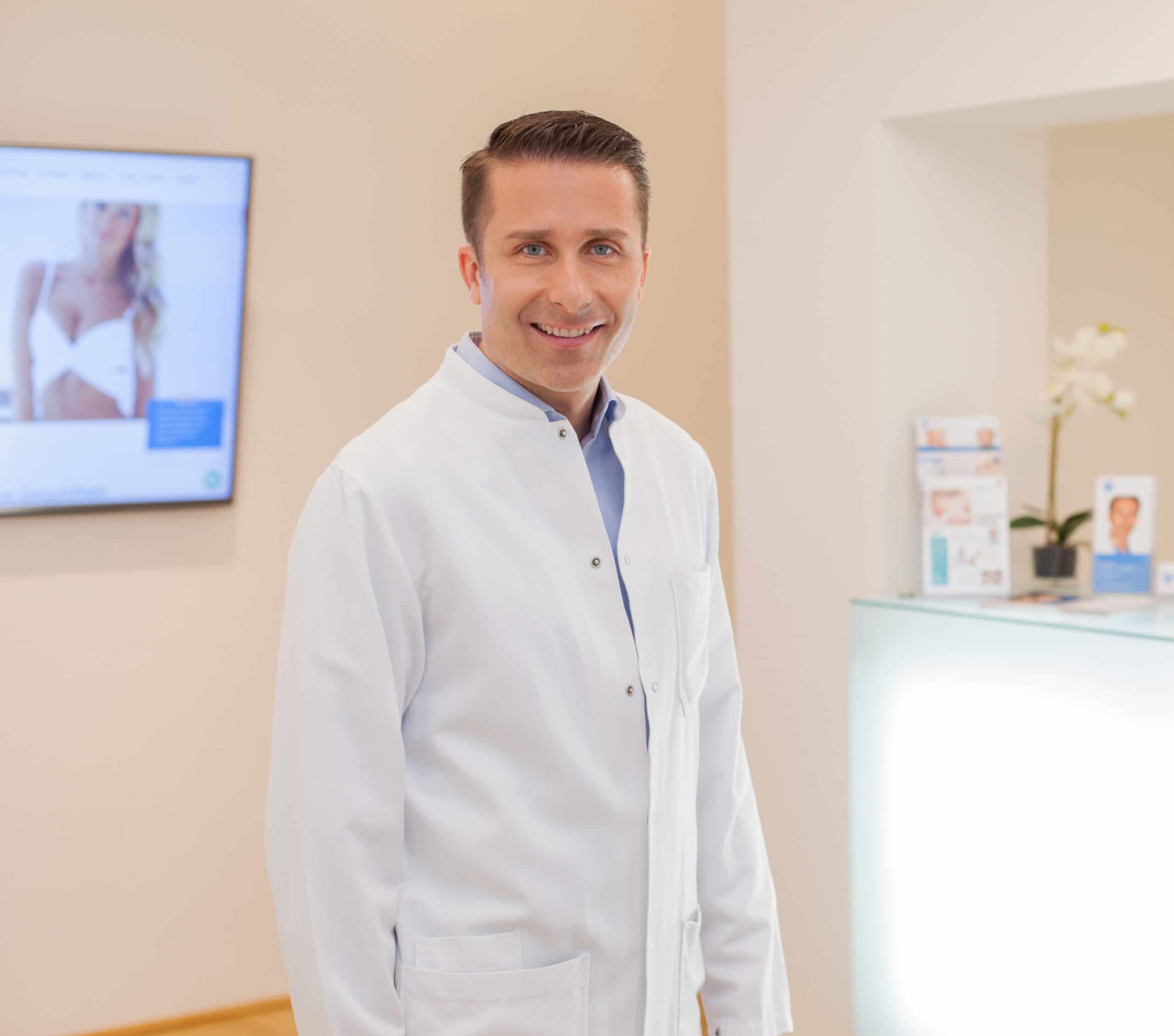For those affected, lipedema means pain, shame and prejudice against an apparently unhealthy lifestyle. A conscious diet and exercise alone can hardly affect this pathological fat distribution disorder. As far as we know today, liposuction is the only therapy that effectively and sustainably treats lipedema. A treatment with Dr. Matiasek not only offers you a completely new attitude to life, but also a particularly gentle method with vibration-assisted liposuction.
What are the symptoms of lipedema?
Characteristic of lipedema is an enlargement and proliferation of fat cells as well as permeable and brittle blood vessels. Women are almost exclusively affected, so genetic and hormonal triggers are considered likely. Puberty, pregnancy, the use of birth control pills and menopause often cause a disease flare-up with a marked worsening of symptoms.
The natural fat store as an energy reserve is mostly located in women on the hips, thighs and buttocks, and the fat accumulations of lipedema are usually symmetrical on both legs. Furthermore, the lipedema can reach down to the lower legs, whereby the feet are spared and thus form a sharp contrast to the diseased tissue above the ankle. The arms are less often affected, leaving out the hands. As a result, there are usually big differences between a very slim upper body and very large legs, which can lead to needing several different dress sizes.
The disease is progressive, which means it gets worse and worse. There are three different stages for this. Stage I shows smooth skin with a soft and thickened subcutaneous fatty tissue, also known colloquially as orange peel. Uneven skin with larger dents and small lumps in the thickened subcutaneous fatty tissue appear in stage II. Stage III is characterized by uneven skin in deformed large skin flaps and skin bulges with a thickened and hardened subcutaneous fatty tissue.
Women with lipedema quickly show painful bruises (bruises) even with minimal bumps, and they also suffer from a tendency to swell and accumulate fluid (edema), which brings pain, tenderness and tension. Pain can also be triggered by inflammation processes in the tissue. However, the skin usually stays cool due to the poor blood circulation. Overstressing the lymphatic system with the evacuation of the fluid can lead to irreparable damage as lipolymphedema with chronically inflamed cell spaces.
Lipedema often means significant restrictions in everyday life, ranging from rapid fatigue to immobility due to heavy legs. Rubbing thighs often causes wounds and eczema, which the patient tries to compensate with a changed gait pattern. This means additional stress on the joints, often accompanied by listlessness leading to a depressive mood, further weight gain or eating disorders that further aggravate the disease. All of this, of course, has a devastating effect on the patient’s self-esteem.
Since physical decongestion therapy (KPE), a combination of lymphatic drainage, movement and compression primarily treats the accumulation of fluid, its success is only short-lived and in no way sustainable after the therapy is ended. Not so with liposuction, which is the only method that removes the fat cells directly, increasing freedom of movement and reducing pain and fluid retention.
Dr. Matiasek prefers to work with the technique of gentle vibration-assisted liposuction (PAL-power assisted liposuction) which, in comparison to other methods, barely affects the connective tissue with the blood vessels, lymphatics and nerves it contains.

What do I have to consider before treating lipedema?
At the beginning of every treatment there is a consultation, in which Dr. Matiasek inquires about your previous illnesses and gives you a physical exam to calculate the amount of fat to be removed. To rule out any complications, an operation under general anesthesia requires certain preliminary examinations such as a blood test or an EKG. Further preparatory examinations or treatments are required individually, including an ultrasound examination, lymph scintigraphy, manual lymph drainage or the treatment of venous problems and varicose veins, the wearing of compression garments or thrombosis prevention.
Blood-thinning medications increase the bleeding tendency and must be discontinued prior to the operation by prior arrangement. Drink enough water, but never alcohol, the day before the operation. Smoking impairs wound healing, so give up consumption two weeks before the appointment.
What is the treatment for lipedema?
The operation itself takes place under sedation or under general anesthesia. At the beginning, Dr. Matiasek applies a so-called tumescent solution to the adipose tissue, a mixture of a saline solution, bicarbonate, a local anesthetic and highly diluted adrenaline. This mixture reduces the tendency to bleed, at the same time the tissue is numbed and ideally prepared for the suction. After an exposure time of 60 to 90 minutes, liposuction can be started. The vibrations of the cannula loosen the cell structure of the fat cells further, so they can be sucked up more easily without damaging the connective tissue. In addition, the vibrations tighten the skin, so that no further skin tightening procedure is normally necessary. Slight forward and backward movements of the cannula enable even suction and prevent the creation of unsightly dents. However, not all of the fat is removed; a thin layer of fat must be retained. Finally, the small punctures are masked with special plasters and compression garments are put on.


What complications can arise in the treatment of lipedema?
Every procedure involves certain risks, including liposuction. General anesthesia, in particular, comes with its own dangers: It puts more stress on the cardiovascular system and increases the likelihood of allergies, thrombosis or pulmonary embolism. In addition, with every procedure there is a risk of wound healing disorders, infections, inflammations and bleeding.
The normal reactions after liposuction include swelling, bruising, water retention and sensory disturbances such as numbness or discomfort in the form of tingling sensations, which can persist for months. Fat embolism, irregularities in the skin surface such as dents, overhanging remaining fat pads or sagging skin, cyst formations, hardening in the subcutaneous tissue as well as asymmetrical results are much rarer thanks to the gentle process, but never completely ruled out.
The small puncture sites usually heal without scars, but some patients tend to develop unsightly scarring. If these areas are exposed to the sun too early, pigment shifts are also possible.
What should I watch out for after lipedema treatment?
As a rule, patients spend one night inpatient so that they can recover from the operation in peace. It is best to be picked up when you are discharged. At first, I recommend rest and a sufficient amount of water to drink. Alcohol and nicotine should remain taboo until completely cured. Despite everything, you should go for a walk or do foot exercises the day after the operation, this will reduce the risk of thrombosis and support drainage. On the first day, individual severe pain is possible, but it can easily be treated with a pain relief. Afterwards, a muscle-sore-like feeling arises, which improves over time.
Dr. Matiasek will schedule several follow-up examinations in which he will examine the healing process and possible complications. He also prescribes antibiotics for his patients to prevent inflammatory reactions. If there is excessive water retention after the operation, it may be necessary to take diuretics. In the first three days after the operation, the remains of the tumescent fluid drip from the puncture sites and collected with special absorbent bandages that you have to change regularly. Cooling can relieve swelling and bruising.
The wearing of compression garments is essential for healing, it supports the regression of skin and tissue and at the same time prevents the accumulation of fluid in the cavities and thus the formation of undesirable dents. In the beginning you have to consistently wear the compression underwear day and night, but after a certain time wearing it during the day is sufficient. Individually, some patients need further therapies and lymphatic drainage for problem-free lymph flow.
Exactly when you can go back to work depends on many factors, including how much fat has been extracted. Most patients feel recovered enough after three to four days. After about two to six weeks, you will be able to exercise again; Sports that involve jerky movements or vibrations should, however, be avoided for a long time. Sunbathing and visits to the solarium increase the risk of pigment shifts. Only when the last bruises have healed after about four weeks can they be safely taken up again.
When are the results of the treatment for lipedema visible?
The healing takes time, especially the tightening of the skin takes a few weeks. Therefore, it can take twelve to 18 months to see the final result. Depending on the severity of the lipedema, several sessions are necessary, as an unlimited amount of fat cannot be suctioned off in one session. These sessions take place approximately four weeks apart. On the other hand, the result is often permanent. Of course, the remaining fat cells multiply again, but much more slowly, so that no new treatment is usually necessary. One exception is weight gain, which of course also increases the percentage of fat. A second operation is possible eight to twelve years after the first operation.
Lipedema is not a disease that you must silently endure with only symptom relief. Dr. Matiasek will be happy to help you not only achieve a much better quality of life, but also the beautifully shaped legs of your dreams.










